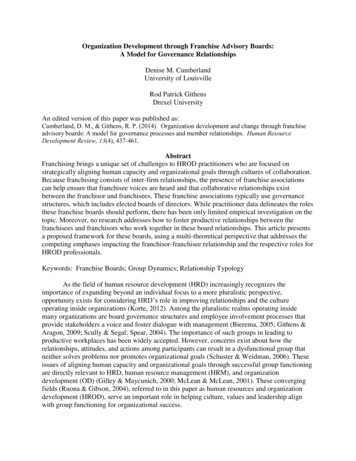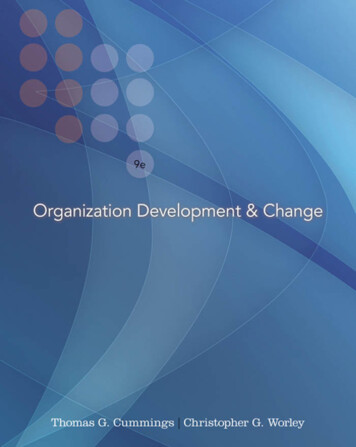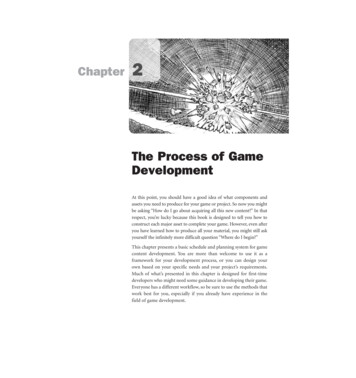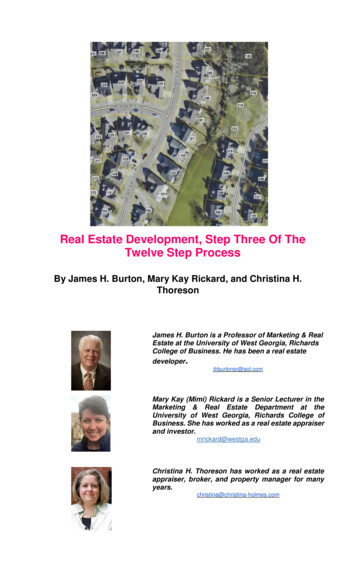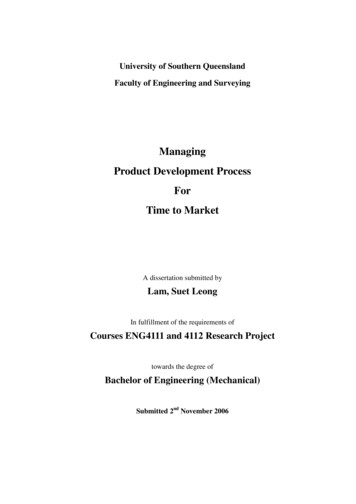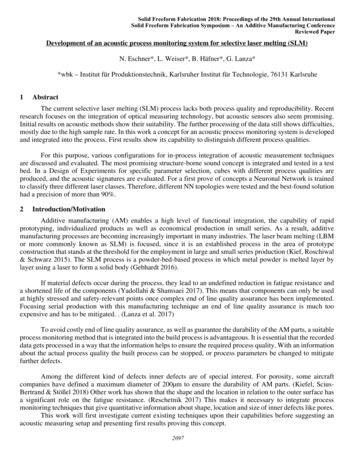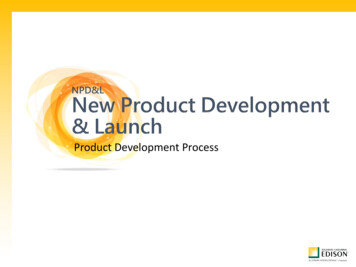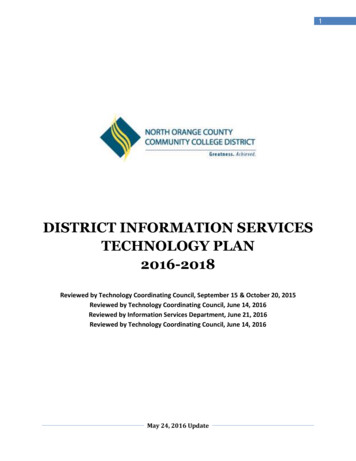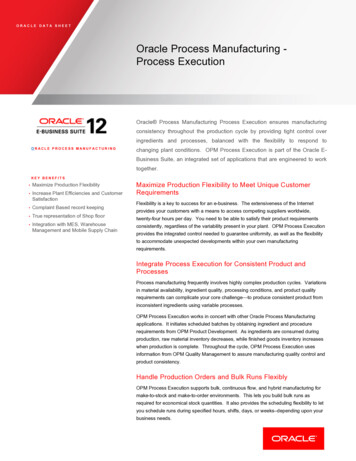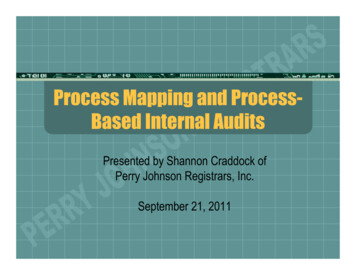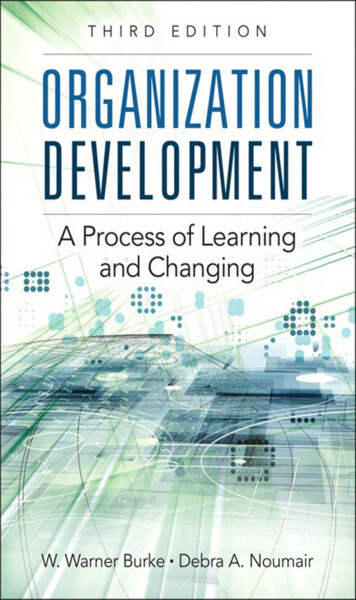
Transcription
OrganizationDevelopmentA Process ofLearning and ChangingThird EditionW. Warner BurkeDebra A. Noumair
Publisher: Paul BogerEditor-in-Chief: Amy NeidlingerExecutive Editor: Jeanne LevineDevelopment Editor: Natasha WolmersOperations Specialist: Jodi KemperCover Designer: Alan ClementsManaging Editor: Kristy HartSenior Project Editor: Betsy GratnerCopy Editor: Karen AnnettProofreader: Debbie WilliamsIndexer: WordWise Publishing ServicesSenior Compositor: Gloria SchurickManufacturing Buyer: Dan Uhrig 2015 by Pearson Education, Inc.Upper Saddle River, New Jersey 07458For information about buying this title in bulk quantities, or for special salesopportunities (which may include electronic versions; custom cover designs; and contentparticular to your business, training goals, marketing focus, or branding interests), pleasecontact our corporate sales department at corpsales@pearsoned.com or (800) 382-3419.For government sales inquiries, please contact governmentsales@pearsoned.com.For questions about sales outside the U.S., please contact international@pearsoned.com.Company and product names mentioned herein are the trademarks or registeredtrademarks of their respective owners.All rights reserved. No part of this book may be reproduced, in any form or by anymeans, without permission in writing from the publisher.Printed in the United States of AmericaFirst Printing February 2015ISBN-10: 0-13-389248-4ISBN-13: 978-0-13-389248-2Pearson Education LTD.Pearson Education Australia PTY, LimitedPearson Education Singapore, Pte. Ltd.Pearson Education Asia, Ltd.Pearson Education Canada, Ltd.Pearson Educación de Mexico, S.A. de C.V.Pearson Education—JapanPearson Education Malaysia, Pte. Ltd.Library of Congress Control Number: 2014955391
This book is dedicated to the students,participants, and alumni of theSocial-Organizational Psychology Program:Ph.D., M.A., Eisenhower Leadership DevelopmentM.A. Program (ELDP), Army Fellows Program,Executive M.A. Program in Change Leadership(XMA), Principles and Practices ofOrganization Development (PPOD),and Executive Education Programs in Changeand Consultation in the Department ofOrganization and Leadership at Teachers College,Columbia University.
This page intentionally left blank
ContentsPreface . . . . . . . . . . . . . . . . . . . . . . . . . . . . . . . . . . . . . . .xiiPart IThe Field of Organization DevelopmentChapter 1What Is Organization Development? . . . . . . . . . . . . . . . .1A Case: Organization Development or CrisisManagement?. 2Definitions. 8A Total System Approach . 13Conclusion. 16Chapter 2Organization Development Then and Now . . . . . . . . . .17Some Significant Changes Between 1969 and 1994 . 17The New Corporation . 26Significant Changes Since 1994 . 27Conclusion. 44Chapter 3Where Did Organization Development Come From?. .45Before OD . 45Theoretical Roots . 50Conclusion. 67Chapter 4Organization Development as a Process of Change. . . .69Action Research . 69Lewin’s Three-Step Procedure of Change . 70Schein’s Elaboration of Lewin’s Three-Stage Model . 72Phases of Planned Change . 74Summary of Action Research Methodology . 77The Generic Model for Organizational Change . 79Practicing OD: A Case History . 82Phases of OD Practice . 89Conclusion. 99Endnote . 100
viORGANIZATION DEVELOPMENTPart IIUnderstanding Organizations: DiagnosisChapter 5Defining the Client: A Different Perspective . . . . . . .101Relations and Interfaces . 104Theory . 105Practice . 108Conclusion. 113Chapter 6Understanding Organizations:The Process of Diagnosis. . . . . . . . . . . . . . . . . . . . . . . .115Organizational Models . 116Normative Theories . 133Conclusion. 142Chapter 7The Burke-Litwin Model of OrganizationalPerformance and Change . . . . . . . . . . . . . . . . . . . . . . .145Background . 145The Model . 147Conclusion. 158Endnote . 159Chapter 8Understanding Organizations: Covert Processes . . . . .161Combining Group Relations and OrganizationDevelopment. 162Beneath the Surface of the Burke-Litwin Model . 166A Case: Beyond the Presenting Problem—A VeiledSuccession . 168Discussion . 181Conclusion. 182Endnote . 184Part IIIChanging OrganizationsChapter 9Planning and Managing Change . . . . . . . . . . . . . . . . . .185Criteria for Effective Intervention . 186Planning the Intervention or Change . 187Managing the Change Process . 192Measuring Progress of the Change Effort . 204Conclusion. 205Two Caveats . 206Endnote . 208
CONTENTSChapter 10viiUnderstanding and Changing Loosely CoupledSystems . . . . . . . . . . . . . . . . . . . . . . . . . . . . . . . . . . . . . .209Two Precautions Regarding Either-Or Thinking . 211The Change Problem . 214Loosely Coupled Systems and the Change Process:Social Network Analysis . 216Loosely Coupled Systems and the Change Process:Additional Potential Interventions . 222Conclusion. 236Endnotes . 237Chapter 11Does Organization Development Work? . . . . . . . . . . .239Does It Work? . 239Research Issues in Evaluating OD Efforts . 243Conclusion. 252Chapter 12The Organization Development Consultant . . . . . . . .255Context for Roles and Functions. 255Roles and Functions . 257Consultant Abilities. 263OD Values . 265Becoming an OD Consultant and IntegratingOD Competencies into Other Organizational Roles. 269Self-as-Instrument . 275Reflective Practice . 277Conclusion. 279Chapter 13Coaching and Organization Development . . . . . . . . . .281Definitions. 283Types of Coaching . 287Coaching Process . 290Coaching Roles and Contexts . 292Coaching Culture . 298Point of View . 300Conclusion. 302
viiiORGANIZATION DEVELOPMENTConclusionChapter 14Organization Development and the Future . . . . . . . . .307Summary of the Final Chapter in the Second Edition. 307Current and Future Trends in OrganizationDevelopment. 310Dialogic Organization Development . 311Leadership Development . 315Positive Psychology . 317Agility: Organizational and Individual. 319Conclusion. 324References . . . . . . . . . . . . . . . . . . . . . . . . . . . . . . . . . . .325Index . . . . . . . . . . . . . . . . . . . . . . . . . . . . . . . . . . . . . . . .355
About the AuthorsW. Warner Burke is the E. L. Thorndike Professor ofPsychology and Education and a founder of the graduate programsin social-organizational psychology at Teachers College, ColumbiaUniversity. Originally educated as a social-organizational psychologist(Ph.D., University of Texas, Austin), Dr. Burke is currently engagedin teaching, research, and consulting. He teaches leadership andorganization change and consultation. His research focuses on multirater feedback, leadership, organization change, and learning agility.Dr. Burke’s consulting experience has been with a variety of organizations in business/industry, education, government, religious, healthcare systems, and professional services firms.Prior to his move to Teachers College, Dr. Burke was Professorof Management and Chair of the Department of Management atClark University. Prior to the Clark assignment, Dr. Burke was anindependent consultant from 1974 to 1976. For eight years he was afull-time professional with the NTL Institute for Applied BehavioralScience, where he was Director for Executive Programs and Directorof the Center for Systems Development (1966–1974). For eight yearsbeginning in 1966, he also served as the Executive Director of theOrganization Development Network.Dr. Burke is a Fellow of the Academy of Management, theAssociation for Psychological Science, and the Society of Industrialand Organizational Psychology. He has served on the Board ofGovernors of the Academy of Management and the AmericanSociety for Training and Development (now Association for TalentDevelopment), and he is a Diplomate in industrial/organizationalpsychology, American Board of Professional Psychology. From 1979to 1985 he was Editor of the American Management Association’squarterly, Organizational Dynamics, and from 1986 to 1989 heoriginated and served as Editor of the Academy of ManagementExecutive. Dr. Burke is the author of more than 150 articles andbook chapters on organization development, training, change andorganizational psychology, and conference planning and author,
xORGANIZATION DEVELOPMENTcoauthor, editor, and coeditor of 20 books. His latest (2014) book isOrganization Change: Theory and Practice, 4th Edition (Sage).Among his many awards are the Public Service Medal from NASA,the Distinguished Scholar-Practitioner Award from the Academy ofManagement, Lifetime Achievement Awards from the OD Networkand Linkage, and the Distinguished Professional ContributionsAward from the Society of Industrial and Organizational Psychology.Debra A. Noumair is Founder and Director of the ExecutiveMasters Program in Change Leadership (XMA), Director of ExecutiveEducation Programs in Change and Consultation, Academic ProgramCoordinator of Graduate Programs, and Associate Professor, inSocial-Organizational Psychology in the Department of Organizationand Leadership at Teachers College, Columbia University. ProfessorNoumair is currently engaged in teaching, research, consulting, andcoaching; the focus of her work is on applying systems psychodynamicsto executive education as well as to organization change at multiplelevels with individuals, teams, and organizations. She teaches courseson organization change and consultation and executive coaching.Dr. Noumair is a coeditor of the Emerald book series, Researchon Organization Change and Development, and a coeditor of GroupDynamics, Organizational Irrationality, and Social Complexity:Group Relations Reader 3. She serves on the Editorial Boards of TheJournal of Applied Behavioral Science and the OPUS InternationalJournal, Organisational and Social Dynamics.As director of numerous leadership development programs, Dr.Noumair brings her work on individual, group, and organizationaldynamics to executives through examining multi-rater feedbackand psychological assessments at the individual and group level andthrough teaching and executive coaching with senior executivesnationally and internationally. Much of her executive education workinvolves partnering with organizations to address the advancement ofwomen through teaching group dynamics and assessment-anchoredexecutive coaching. Dr. Noumair consults to organizations on culturechange, senior team effectiveness, intergroup and interorganizationalrelations, and issues related to diversity at work. A group relationsscholar and practitioner, Dr. Noumair is a Fellow of the A. K.Rice Institute. She has consulted to and directed group relations
ABOUT THE AUTHORSxiconferences nationally and served on the Board of Directors of the A.K. Rice Institute for nine years.Dr. Noumair received her bachelor’s degree from BostonUniversity and holds masters and doctoral degrees from TeachersCollege, Columbia University. She is a member of the AmericanPsychological Association, the Academy of Management, and theOrganization Development Network.
PrefaceI wrote the first two editions of this book on organization development (OD) in 1987 and 1994, respectively. The significant changefor this third edition is the addition of my coauthor, Debra Noumair.We have been colleagues at Teachers College, Columbia University,for two decades and have worked together on numerous projects andseveral courses within our social-organizational psychology programs,which she now directs.It was clear that the second edition, slightly more than 20 yearsold, was dated. It was also clear that some more recent perspectivesand additions were in order, such as integrating covert processesinto organization diagnosis, consulting to loosely coupled systems,and coaching and OD. Although massive change in the field has notoccurred in the last two decades, plenty of change has evolved. Therefore, instead of the 11 chapters in the second edition, we now have14, and with an exception or two (history remains the same), all otherchapters have been revised, some significantly, such as Chapters 2,12, and 14. A chapter-by-chapter summary follows, but a few wordsof clarification first: the intended audience for this book and somepersonal biases.We have three audiences in mind: (1) the manager, executive, oradministrator—that is, a potential user of organization development;(2) the practitioner in the field—that is, a user who may need someguidelines for his or her practice either as a consultant internal to anorganization or as an external consultant working with a consultingfirm or as an independent practitioner; and (3) the student—one whomay in the future use the information provided in either of roles (1)or (2).And now a brief word of clarification: Although we believe wehave been reasonably objective in defining and describing OD, thetheories underlying the field, and the way practitioners typically work,we do have a bias. While defining OD, we also present what we thinkOD should be; that is, a clear goal of change in the organization’s culture. An organization’s culture is the single greatest barrier to changefor any system, whether profit-making or nonprofit, government,
PREFACExiiieducational, or religious institution. Not everyone will agree with thisbias, but agreement or disagreement should not prevent a reasonableunderstanding of how we have described the concepts and practicesof organization development.What follows is a summary statement of the content for each ofthe 14 chapters organized in three parts plus a Conclusion.Part I, “The Field of Organization Development”Chapter 1, “What Is Organization Development?,” presents anactual case based on a consulting assignment, which succinctlyillustrates the primary characteristics of OD practice, althoughtaking into account what OD should be (our bias), it does notexemplify what OD really is.Chapter 2, “Organization Development Then and Now,” is significantly revised and focuses on the impact of the external environment on OD. It first summarizes the previous second edition with the nine significant changes between 1969 and 1994and then covers nine newer trends that are under way as of2014 and likely will be influential for the foreseeable future.Chapter 3, “Where Did Organization Development ComeFrom?,” remains essentially the same as before and traces theroots or forerunners of the field as well as briefly describes tentheories related to organizational behavior that underlie ODpractice.Chapter 4, “Organization Development as a Process of Change,”covers the fundamental models of change that guide OD practitioners and, using another actual case to illustrate, also coversthe phases of consultation that OD practitioners follow in theirpractice.Part II, “Understanding Organizations: Diagnosis”Chapter 5, “Defining the Client: A Different Perspective,” addresses the question of who the client is, which might seemobvious, but isn’t. This perspective considers the client in termsof relationships.
xivORGANIZATION DEVELOPMENTChapter 6, “Understanding Organizations: The Process of Diagnosis,” describes some of the most common frameworks ororganizational models that OD practitioners use after they haveconducted their interviews and perhaps administered questionnaires, made their observations, and read some documents andthen attempted to make systematic sense out of what often atfirst seems a mass of confusing data.Chapter 7, “The Burke-Litwin Model of Organizational Performance and Change,” extends and builds on the previous chapter by describing our own way of thinking about organizationsand changing them. The significant change that occurred atBritish Airways during the latter half of the 1980s is explainedto illustrate how the Burke-Litwin model was used as a framework.Chapter 8, “Understanding Organizations: Covert Processes,”is a new chapter that addresses those organizational issues thatexist beneath the surface—the “undiscussables,” matters of collusion, and what might be referred to as the collective unconscious. Central to the chapter is an actual case that brings theseissues to the surface and provides a framework for integratingcovert processes with OD models, tools, and practice.Part III, “Changing Organizations”Chapter 9, “Planning and Managing Change,” explains whatOD practitioners do after the diagnostic phase and includesmany of the primary steps involved in managing change as wellas theory about organizational culture change. With change ingeneral being more rapid than ever and with organizations being more differentiated than ever, we end the chapter with twocaveats—we may not have as much time to plan our changeeffort as we would like, and we can no longer assume that mostorganizations today follow the organizational model of GeneralMotors in the days of Alfred P. Sloan (1946), the model of itsday for corporate America.Chapter 10, “Understanding and Changing Loosely CoupledSystems,” another new chapter, compares and contrasts looselycoupled systems with tightly coupled systems and explores the
PREFACExvcomplexities of attempting to change a loosely coupled system,a network or political party, for example. Social network analysis is a popular and useful tool for understanding loosely coupled systems. Other political tools and interventions, such aslarge group techniques that can be useful for changing a looselyversus tightly coupled system, are explored.Chapter 11, “Does Organization Development Work?,” presents some summary evidence that OD does work, brings theevidence up to date, highlights the issues in evaluating OD efforts, and provides the key reasons in support of conducting anevaluation.Chapter 12, “The Organization Development Consultant,” issignificantly revised and covers OD consultant roles and functions, abilities required of an OD practitioner, OD values, waysto become an OD consultant, self as instrument, and reflectivepractice. This chapter also addresses the shift toward integrating OD skills into line functions and managerial and leadershiproles in organizations.Chapter 13, “Coaching and Organization Development,” another new chapter, covers the field of coaching and its relationto OD. Although coaching as a process of teaching and learninghas been around for centuries, as a distinct field within organizations and primarily for executives, managers, and supervisors,it is comparatively new. There are different roles and functionsof coaching and OD practitioners need not only be aware ofthese processes, but also incorporate coaching into organizationdevelopment and change.ConclusionChapter 14, “Organization Development and the Future,”is significantly revised and provides an overview of currentand future trends in OD and then summarizes four primarytrends currently under way and likely to influence the fieldof OD in the foreseeable future. These four are dialogic OD,leadership development, positive psychology, and agility bothorganizational and individual. The chapter ends with an overallsummary.
xviORGANIZATION DEVELOPMENTWriting a book—even one that is a revision, a third edition of anearlier one—requires long hours of digging into the more recent andrelevant literature, concentrating on what needs updating, what newtopics need to be added, and what is not necessary to incorporate intothis latest edition. But the long hours have been rewarding becausenew learning for us has been realized. This learning has come fromboth new theory concepts and research, as well as from new and different practice. The joy comes from seeing how theory and researchcan influence practice and how practice can inform what new researchand theory needs to be conducted. Completing this third editiontherefore strengthens our self-identity of being scholar-practitioners.And, finally, with respect to helping us to bring this book to theprinted page, we wish to express our deep gratitude to Ms. AmbarUreña for her skill at typing and use of the computer, her administrative abilities, and most important, her positive, can-do attitude.New York, NYW. Warner BurkeDebra A. Noumair
1What Is Organization Development?The term organization development, or OD, the label most commonly used for the field, has been in use since at least 1960. In the’60s and early ’70s, jokes about what the abbreviation OD meant werecommon. Today, few people in the world of large organizations associate OD with overdose, olive drab, or officer of the day, however.Organization development as a field may not yet be sufficiently knownto be defined in the dictionary or explained in the Encyclopedia Britannica, but it has survived some turbulent times and will be aroundfor the foreseeable future. Although not defined in these well-knownstandards for definitions, organization development is defined in theEncyclopedia of Management Theory, Volume Two (Kessler, 2013)albeit requiring more than five double-columned pages. Moreover ifwe do check Webster’s dictionary and look for the definition of development, we will find that part of the definition is as follows: Evolve possibilities Make active Promote growth Make available or usable resources the organization has Move from an original position to one that provides moreopportunity for effective useIn other words, we could hardly do better attempting to find amore appropriate lead-in to what OD means.Explaining what OD is and what people do who practice OD continues to be difficult nevertheless because the field is still beingshaped to some degree and because the practice of OD is more of aprocess than a step-by-step procedure. That is, OD is a considerationin general of how work is done, what the people who carry out the1
2ORGANIZATION DEVELOPMENTwork believe and feel about their efficiency and effectiveness, ratherthan a specific, concrete, step-by-step linear procedure for accomplishing something.An example should help to explain. The following case representsa fairly strict, purist stance for determining what OD is and what itis not.A Case: Organization Development or CrisisManagement?The client organization was a division of a large U.S. manufacturing corporation. The division consisted of two plants, both of whichmanufactured heavy electrical equipment. The division was in troubleat the time I (Burke) was hired as an OD consultant. There werequality and control problems and customers were complaining. Thecomplaints concerned not only poor quality, but also late deliveryof products—inevitably weeks, if not months, later than promised.Several weeks prior to my arrival at the divisional offices, a seniorvice president (VP) from the corporation’s headquarters had visitedwith the division’s top management team, a group of six men. Thecorporate VP was very much aware of the problems, and he was anything but pleased about the state of affairs. At the end of his visit,he made a pronouncement, stating in essence that, unless this division was “turned around” within six months, he would close it down.This ultimatum would mean loss of jobs for more than 1,000 people,including, of course, the division’s top management team. Althoughthe two plants in this division were unionized, the corporate VP hadthe power and the support from his superiors to close the division ifhe deemed it necessary.For several months before this crisis, the division general manager had taken a variety of steps to try to correct the problems. Hehad held problem-solving meetings with his top management team;he had fired the head of manufacturing and brought in a more experienced man; he spent time on the shop floor talking with first-linesupervisors and workers; he authorized experiments to be conducted
CHAPTER 1 WHAT IS ORGANIZATION DEVELOPMENT?3by the production engineers to discover better methods; and he evenconducted a mass rally of all employees at which he exhorted them todo better. After the rally, signs were placed throughout the divisionannouncing the goal: to become number one among all the corporation’s divisions. None of these steps seemed to make any difference.The general manager also sought help from the corporate staffof employee relations and training specialists. One of these specialists made several visits to the division and eventually decided that anoutside consultant with expertise in organization development couldprobably help. I was contacted by this corporate staff person, and anexploratory visit was arranged.My initial visit, only a few weeks after the corporate vice president had made his visit and his pronouncement, consisted largely of(1) talking at length with the general manager, (2) observing brieflymost of the production operations, (3) meeting informally with thetop management team so that questions could be raised and issuesexplored, and, finally, (4) discussing the action steps I proposed. I suggested we start at the top. I would interview each member of the topmanagement team at some length and report back to them as a groupwhat I had diagnosed from these interviews; then we would jointlydetermine the appropriate next steps. They agreed to my proposal.A couple of weeks later, I began by interviewing the six members of the top management team (see Figure 1.1) for about an houreach. They gave many reasons for the division’s problems, some ofthe presumed causes contradicting others. What became apparentwas that, although the division’s goals were generally understandable,they were not specific enough for people to be clear about priorities. Moreover, there were interpersonal problems, such as conflictbetween the head of marketing and the head of employee relations.(The marketing manager believed that the employee relations manager was never forceful enough, and the employee relations managerperceived the marketing manager as a blowhard.) We decided to havea two-and-a-half-day meeting of the top management team at a hotelsome 90 miles away t
quarterly, Organizational Dynamics, and from 1986 to 1989 he originated and served as Editor of the Academy of Management Executive. Dr. Burke is the author of more than 150 articles and book chapters on organization development, training, change and organ


